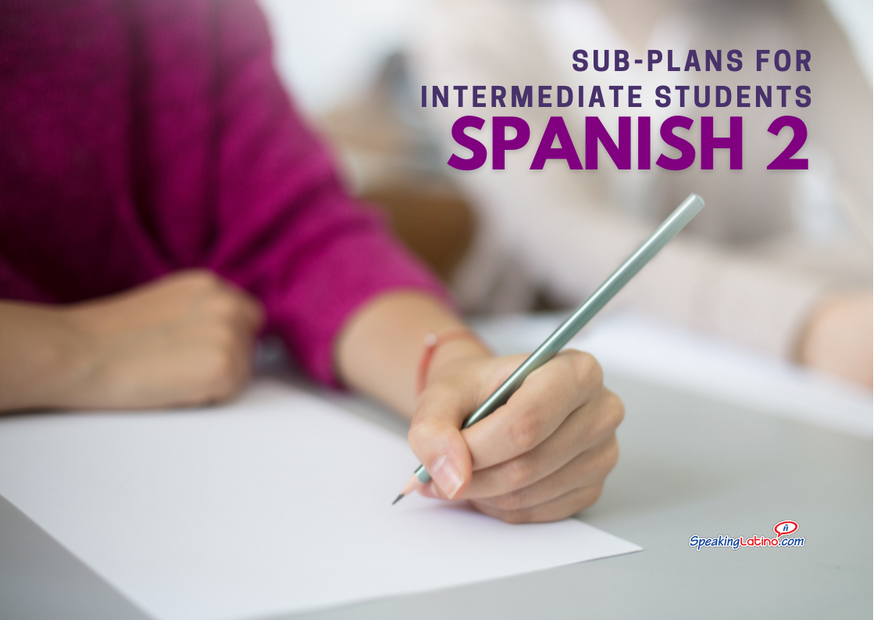
A Spanish sub-plan for intermediate students may include irregular verb conjugations and tenses, comprehension exercises involving short conversations or news articles, more advanced written assignments such as stories or persuasive letters, listening comprehension of conversations in authentic videos, and discussions about cultural aspects of the Spanish-speaking countries.
If the sub-teacher that covers you does not speak Spanish, it is crucial for you to be extra organized and prepared. It is important to have the substitute lesson plan, as well as any materials needed for activities, already laid out and clearly explained. We recommend having an emergency sub-plan always ready in your classroom.
Additionally, it would be helpful to create a list of useful Spanish words or phrases the substitute could use to help students understand instructions.
You should also make a note about your classroom setting and class rules your students should follow (for example, no cell phones). Also highlight any special accommodation or needs of individual students so that the sub-teacher can ensure each student is receiving an effective learning experience. If you don’t have time to write all this down, record a short video or audio to let your colleague know about any important details before stepping into your classroom.
Spanish Sub-Plans for Intermediate High School Students
Here are suggested Spanish sub-plans for intermediate and intermediate-advanced students that are ready to use (even if your sub-teacher doesn’t speak Spanish):
 Guatemala and Sweet 16 Verbs Substitute Lesson Plan
Guatemala and Sweet 16 Verbs Substitute Lesson Plan
After completing the text with the correct forms of the appropriate verbs, students will show their understanding of the text and places in Guatemala by labeling the pictures. There are two versions of the text completion task (one with word banks and one with each verb given) as well as two versions of the places labeling activity to allow for different language levels.
 Quinceañera Invitation Substitute Lesson Plan
Quinceañera Invitation Substitute Lesson Plan
At the end of this activity, students will understand what a quinceañera is and show comprehension of a dialogue about an upcoming quinceañera. Students will create an invitation showing their understanding of a quinceañera and the information required in making a complete invitation.
 False Friends Substitute Lesson Plan
False Friends Substitute Lesson Plan
By the end of this activity, students will have reviewed the meaning of the word “cognate. The students will have also identified “false friends,” or words that resemble each other but mean something entirely different, as well as strategies to remember the correct meaning of the Spanish words that might cause confusion.
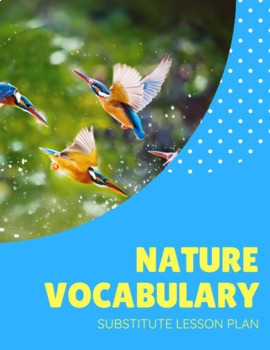 Practice with Nature Vocabulary and Verbs with Nina Simone’s “Feeling Good” Substitute Lesson Plan
Practice with Nature Vocabulary and Verbs with Nina Simone’s “Feeling Good” Substitute Lesson Plan
By the end of this activity, students will identify a list of nature vocabulary in English and be able to translate the words into Spanish.
Students will review the grammar concept of reflexive verbs using the example of the phrase “I feel” in the song lyric.
Students will have practice writing their own song verse in Spanish according to the pattern they observe in the song lyrics attached.
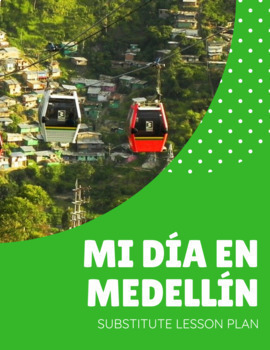 Mi día en Medellín – Spanish Sub Lesson Plan for Intermediate Students
Mi día en Medellín – Spanish Sub Lesson Plan for Intermediate Students
After looking over the two-sided flyer (and referencing an online article if technology permits), students will show their understanding of things to do in Medellín by writing an email detailing the things that they did while visiting the city.
 Introducing Poet Elizabeth Acevedo Substitute Lesson Plan
Introducing Poet Elizabeth Acevedo Substitute Lesson Plan
Students will read a brief article about Elizabeth Acevedo in English. They will discuss what they learn before writing a verse of poetry in English in pairs. For the rest of the class, or homework, they will translate their verse into Spanish to turn in for credit.
By the end of this activity, students will know how to write a haiku poem and understand the rules of haiku-writing. Students will also have a deeper awareness of how syllables work within a Spanish word. Students will have practice writing with Spanish nature vocabulary, applying basic verb conjugations in the present tense to the lines of the poem.
 Recipes for Furry Friends Substitute Lesson Plan
Recipes for Furry Friends Substitute Lesson Plan
By the end of this activity, students will have reviewed Spanish food vocabulary and learned new Spanish vocabulary to describe the food as well as how to prepare it.
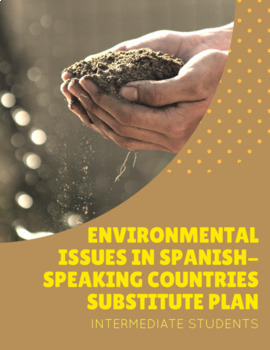 Environmental Issues in Spanish Speaking Countries Sub-Plan
Environmental Issues in Spanish Speaking Countries Sub-Plan
By the end of this activity, students will have researched geographical information about a specific Spanish-speaking country, while learning about environmental issues that impact that particular country. Students will also develop prepare a presentation of their findings, in Spanish and English, to practice their writing and speaking skills.
Spanish Sub-Plans for Intermediate-Advanced Students
 Fairy Tales Substitute Lesson Plan
Fairy Tales Substitute Lesson Plan
By the end of this activity, students will demonstrate their understanding of the differences between the preterite and imperfect tenses by writing their own Spanish sentences. The students will create their own fairy tale in Spanish, using the past tense.
 My Favorite Recipe – Spanish Sub Lesson Plan for Intermediate Students
My Favorite Recipe – Spanish Sub Lesson Plan for Intermediate Students
Students will begin the lesson by reviewing a Quizlet of common cooking vocabulary. Give them 10 minutes to review this list and practice with any of the activities available. Then, students will review a series of videos from the Spanish teacher Señor Flax. The videos will provide students with practice to be able to write their own recipes in Spanish. Many of the videos also have Quizlet and Edpuzzle reviews which the students can complete. After practicing with these videos, students will work on recreating their own favorite dish by making a recipe card in English and Spanish.
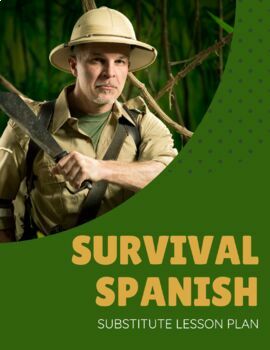 Survival Spanish – Spanish Sub Lesson Plan for Intermediate Students
Survival Spanish – Spanish Sub Lesson Plan for Intermediate Students
The students will begin the lesson with a discussion of what kinds of topics they feel are the most important for people to know when using Spanish outside the classroom. They will identify topics or conversations, grammar, verbs, and vocabulary. They will then break into groups of 3 or 4 and select topics from the class discussion to create their own learning guides for “survival Spanish.” They will choose a presentation method they wish to use and add their own creative flare while working collaboratively to create their guides.
By the end of this activity, students will understand the concept of rhyme scheme and apply their knowledge to examples of poetic language in both Spanish and English. The students will have the opportunity to write their own short verse following a rhyme scheme of their own selection, in Spanish, and then translate it to English.
 Learning by Teaching Grammar – Spanish Sub Lesson Plan for Intermediate Students
Learning by Teaching Grammar – Spanish Sub Lesson Plan for Intermediate Students
One of the best ways to learn something is to teach it. With this adage in mind, students will focus on a particular grammar concept they will find difficult. By breaking the concept down into smaller parts, students will gain a deeper understanding of the concept that they found difficult and perhaps even help others understand the concept better, reinforcing their own knowledge.
Click here for more Spanish Lesson Plans.
 Japanese Haiku Sub-Plan
Japanese Haiku Sub-Plan Poetry Writing Sub-Plan
Poetry Writing Sub-Plan